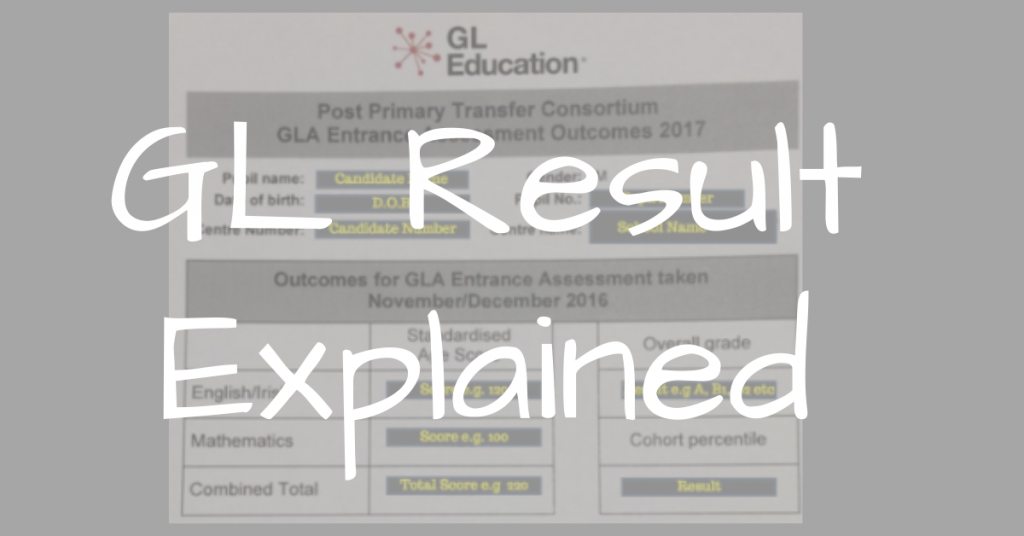
The Result Sheet
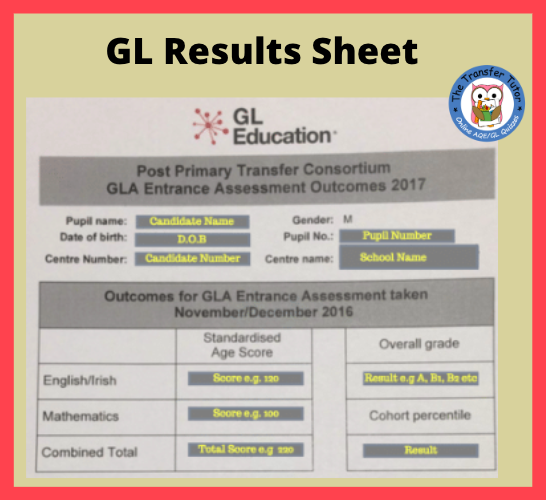
The picture above shows a sample results sheet and so, let’s break this down and explain the various areas in detail.
Personal Information
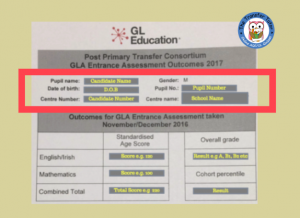
At the top and is simply there to identify the child and confirm their name, date-of-birth, pupil number and centre name.
As well as the parents being reassured that this is indeed the results for their child, this information is necessary when the results are sent off on the post-primary transfer form.
English / Irish – Standardised Age Score
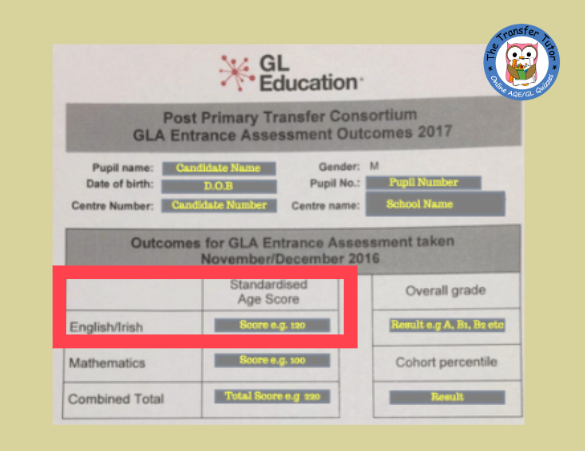
This will be between 69 – 141.
It will be the standardised score that the child achieved in the English paper. A score of 100 is the mean (average).
Maths – Standardised Age Score
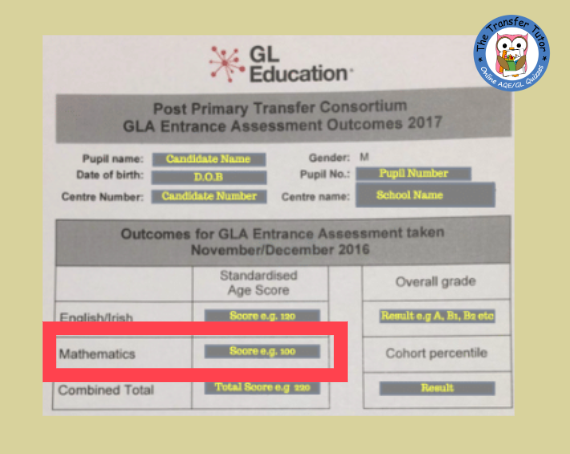
This will be between 69 – 141.
It will be the standardised score that the child achieved in the Maths paper. Again a score of 100 is the mean (average).
Combined Total – Standardised Age Score
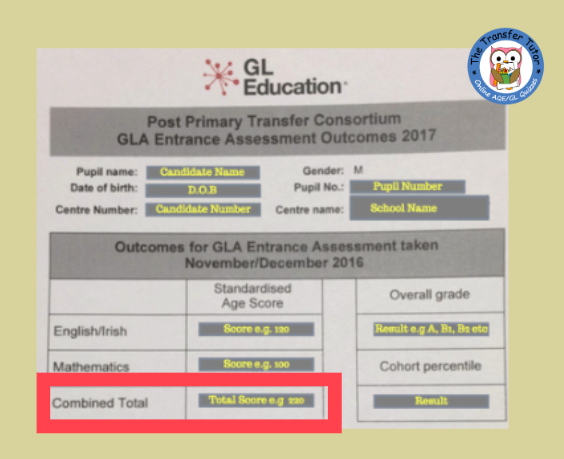
This will be between 138 – 282 .
It’s simply calculated by adding ‘English / Irish Standardised Score’ + ‘Maths Standardised Score‘.
So, in the picture example above, the child got 120 in English/Irish and 100 in Maths, so therefore they received 220 (120 + 100) in their Combined Total.
But don’t be thinking that your child should be getting anywhere near 282 as this is an absolute maximum is almost impossible!
Overall Grade
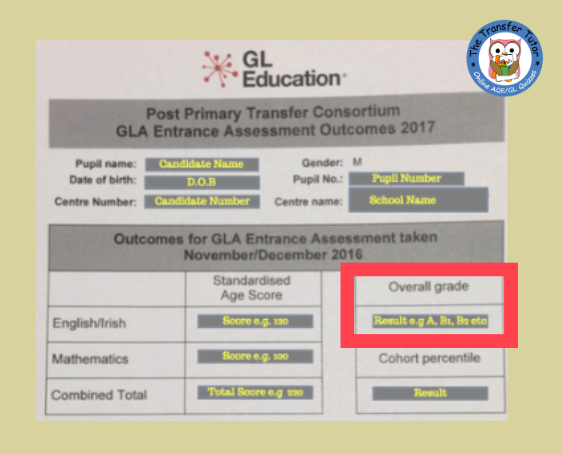
Along with the standardised scores, your child will receive an overall grade of A, B1, B2, C1, C2 or D.
The grades will be based of the Combined Total score.
Although there might be a slight variation, there’s usually not much change from year on year, so using the grade boundaries from 2019, you can begin to understand what’s expected for an A, B1, B2 etc.
- Grade A : Combined Total 234+
- Grade B1 : Combined Total 229 – 233
- Grade B2 : Combined Total 224 – 228
- Grade C1 : Combined Total 219 – 223
- Grade C2 : Combined Total 213 – 218
- Grade D : Combined Total 138 – 212
Cohort Percentile
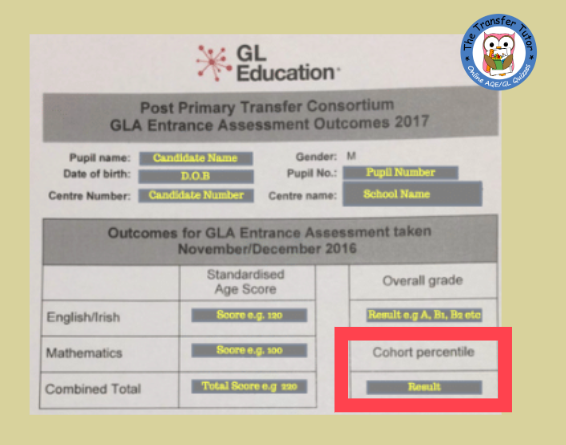
Cohort Percentiles range from <30 to 99+ with 50 as the mean.
This Cohort Percentile is also based on the Combined Total score.
This particular element of the results (the Cohort Percentile) often causes some confusion as it’s not a term you’d often hear or even use during the practice tests in school. The best way to describe this is that it’s a bit like percentages but percentages are based on raw marks whereas percentiles are based on standardised marks.
To try to explain further, you may be familiar with percentiles when your child’s growth and weight was being recorded and plotted on the growth charts in their little, red books, and you would’ve been informed of their percentile at that time. Percentiles are more about the position of the child’s height and weight compared to the average – rather than it being an actual figure.
Some examples which might help to explain the logic:
- If Matthew achieved a cohort percentile of 50, this means that he did better than 50% of the other candidates who took the test.
- If Matthew achieved a cohort percentile of 85, this means that he did better than 85% of the other candidates who took the test.
What Does My Child Need To Get Into Grammar?

The score or grade can vary every year, depending on how many people apply and the scores/grades of applicants.
This is the important question and by having a look at the lowest scores accepted in the last five years in this blog ‘Lowest Scores Accepted From 2019-2014′, you can get an idea of what to expect.
Which Is More Important – Grade, Score or Cohort?

It’s not that one is more important than the other, as they’re all linked – a child who scores an A will also have a high score and a good cohort percentile – but the school might accept entrance based on either grade, score or cohort, so you have to do your homework.
For every school you’re considering for your child, READ THE ADMISSION CRITERIA and know what the school will be looking for, because without this, quite frankly, you’re running blind.
All documents are in this handy blog – Admission Criteria For All Schools.
Customers of The Transfer Tutor App will receive this and other blogs, in a timely fashion, direct to their email inbox.
More about The Transfer Tutor (Multi-Award Winning Online Quizzes)

The Transfer Tutor’s Online Quizzes provide a fun and interactive way to learn and practise Maths and English questions which are directly aligned to both the AQE and GL specifications.
There are many, great features including (but not limited to):
- Quizzes broken down into specific English and Maths topics, to allow for focused learning and the ability to hone in on areas of weakness.
- Mobile friendly and works on any internet device.
- ‘Hint’ option supports the child’s learning. For example, in question about calculating area of an irregular shape, the hint will say, “Break it into two” – enough to keep the child going but teaching them for future, similar questions.
- The Leaderboard at the end makes the child feel like they’re playing a game and having friendly competition.
- Good use of colour and graphics which makes it exciting.
- Parents receives a progress email at the end to let them know how their child did.
Google Reviews

Check out the Google Reviews to read what other customers felt about The Transfer Tutor.
One-off, Great Prices

Try It Out:

To give you a feel for the quizzes, why not try out the quick fire free quiz by clicking on the button below (no need to register or pay, so don’t worry). This will hopefully let you see how the questions work – or more importantly, let you see if this is something that would inspire and encourage your child to learn.
Social Media Links – Keeping Up To Date

Follow or like The Transfer Tutor on your social media channel of choice and ensure you never miss a beat with the whole transfer process, handy tips, advice, special offers and competitions.
Click below for your preferred channel or search for @TransferTutorHQ wherever you are.
Free Facebook Group

You may have read in the reviews about people referring to the Facebook Support Group and this is certainly a great place to keep informed, ask questions, get support and keep up-to-date with anything happening in the transfer space.
It’s free to join but please ensure you have a genuine Facebook profile picture (ghost pictures are not approved as not deemed authentic) and then simply click here and answer the simple questions -> Join Facebook Group.
